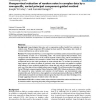Free Online Productivity Tools
i2Speak
i2Symbol
i2OCR
iTex2Img
iWeb2Print
iWeb2Shot
i2Type
iPdf2Split
iPdf2Merge
i2Bopomofo
i2Arabic
i2Style
i2Image
i2PDF
iLatex2Rtf
Sci2ools
BMCBI
2008
2008
Unsupervised reduction of random noise in complex data by a row-specific, sorted principal component-guided method
Background: Large biological data sets, such as expression profiles, benefit from reduction of random noise. Principal component (PC) analysis has been used for this purpose, but it tends to remove small features as well as random noise. Results: We interpreted the PCs as a mere signal-rich coordinate system and sorted the squared PC-coordinates of each row in descending order. The sorted squared PC-coordinates were compared with the distribution of the ordered squared random noise, and PC-coordinates for insignificant contributions were treated as random noise and nullified. The processed data were transformed back to the initial coordinates as noise-reduced data. To increase the sensitivity of signal capture and reduce the effects of stochastic noise, this procedure was applied to multiple small subsets of rows randomly sampled from a large data set, and the results corresponding to each row of the data set from multiple subsets were averaged. We call this procedure Row-specific, So...
| Added | 09 Dec 2010 |
| Updated | 09 Dec 2010 |
| Type | Journal |
| Year | 2008 |
| Where | BMCBI |
| Authors | Joseph W. Foley, Fumiaki Katagiri |
Comments (0)

